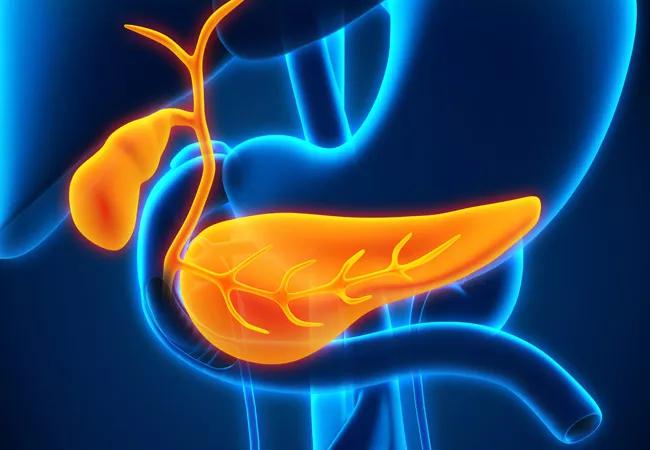Advertisement
Long-term study investigates disease complications and outcomes

Severe inflammation of the pancreas (pancreatitis) can cause irreparable harm to the pancreas and destroy part of the organ (necrosis). With a mortality rate of 25%, necrotizing pancreatitis (NP) can lead to disconnection or disruption of the pancreatic duct (PD). As a result, the main pancreatic duct no longer communicates with the gastrointestinal tract, causing pancreatic fluid to leak into the surrounding tissues. Patients may exhibit chronic abdominal pain and malnutrition.
Advertisement
Cleveland Clinic is a non-profit academic medical center. Advertising on our site helps support our mission. We do not endorse non-Cleveland Clinic products or services. Policy
These concerning complications prompted the Cleveland Clinic Department of Gastroenterology, Hepatology & Nutrition to conduct a major retrospective study of their NP patients. “If you look at data on necrotizing pancreatitis, most studies don’t distinguish between the two types of duct complications or follow patients over the long term,” says Prabhleen Chahal, MD, FASGE, FACG, the leading expert in advanced endoscopy and interventional endoscopic ultrasound (EUS) and a Program Director of Advanced Endoscopy Fellowship in the Department of Gastroenterology at Cleveland Clinic.
The findings were presented during the Plenary session at the 2022 Annual Scientific Meeting of the American College of Gastroenterology (ACG).
The study cohort included 613 NP patients managed at Cleveland Clinic from 2009 to 2019: 476 patients (78%) with intact PD, 94 (15%) with disrupted PD and 43 (7%) with disconnected PD. The study compared clinical characteristics and outcomes for NP patients with intact PD to NP patients with disrupted or disconnected PD. PD disruption was defined as partial interruption of the pancreatic duct and PD disconnection as complete interruption of the pancreatic duct.
Recurrent episodes of NP were more prevalent among patients with disrupted PD (67 [71%]) or disconnected PD (28 [65%]) than in patients with intact PD (263 [55%]). NP involvement of the pancreatic body was more significant among patients with PD disruption (27 [29%]) and disconnection (10 [23%]) than those with intact PD (83 [17%]).
Pancreatic fistulas had a higher prevalence in patients with disrupted PD (15 [16%]) or disconnected PD (7 [16%]) than intact PD. Also, pancreatic fistula formation was four times more likely in patients with disrupted or disconnected PD than those with intact PD. Distal biliary strictures were more common among patients with disrupted PD (29 [31%]) or disconnected PD (11 [26%]) than patients with intact PD. In addition, the disrupted and disconnected PD patient groups developed duodenal ulcers three to six times more often than intact PD patients.
Patients with disconnected PD had the highest occurrence of acute kidney injury (11 [31%]), altered mental status (15, 35%), readmission (20, 47%) and duodenal ulceration (5 [12%]), compared to both intact and disrupted PD patients. Disconnected PD patients had a nearly three-fold increased risk of developing chronic abdominal pain compared to intact or disrupted PD patients.
Advertisement
“This study confirms that the complications we see in practice among patients with disrupted or disconnected PD are statistically true compared to patients with intact PD. Patients with disrupted or disconnected PD tend to have highly alkaline pancreatic secretions and a high risk of fistulas, recurrent attacks and damage to the kidneys and lungs.
“Most important, the study educates us about what patients may face, so we can tell them what to expect and follow them accordingly. Disconnected and disrupted PD complications carry different short- and long-term morbidities,” says Dr. Chahal.
The findings underscore the importance of preventing PD recurrences and addressing major causes, such as high cholesterol and triglycerides, alcoholism and gallstones. “We scrutinize patients’ history and take appropriate measures. We counsel patients with chronic alcohol abuse and refer them to outpatient support,” says Dr. Chahal. “When gallstones are a factor, the gall bladder can be removed, and high cholesterol and triglycerides can be treated with medications.”
While nothing can restore the integrity of the pancreatic duct, interventions exist that can relieve symptoms. If patients have recurrences and a buildup of pancreatic fluid, part of the pancreas can be removed or a stent can be inserted. For patients with disrupted PD where the duct is leaky but intact, ERCP is used to place a stent in the pancreatic duct to reroute the flow to heal the leak. For patients with disconnected PD, an EUS-guided stent can be placed between the stomach and duct to prevent fluid buildup.
The investigators may conduct further research to continue following NP patients over the long term and look at the role of endoscopy in treating complications in patients with disconnected or disrupted PD.
Advertisement
Advertisement

Cleveland Clinic study finds that durable weight loss is key to health benefits

Findings could help promote organ preservation

A proof-of-concept study shows how 3D pouchography can be a useful adjunct for surgeons

New research shows dramatic reduction in waitlist times with new technology

Potential for new, non-invasive screening option

Provider vigilance and patient education are key for management

Reassuring results, but patient education is still important

An individualized approach to care is still essential